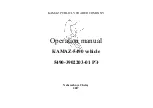
2 Safety - Low Voltage Insulation
The low volt age(LV) in su lated EPV16 is in su lated
to 1000V AC or 1500V DC.
If you have not yet read Chapter 1 "Safety"
then do so now before you read this chapter.
This chapter deals only with safety issues
specifically related to operating an EPV16
with low voltage insulation.
Chapter 1 covers all other aspects involved
in the safe operation of an EPV16 and is
essential reading.
This chap ter does not set out to pro vide any de tail
on the safety is sues or reg u la tions con cerned with
the op er a tion of a low volt age in su lated EPV16
around live conductors.
This chap ter is sim ply in tended to alert the op er a tor
to gen eral safety is sues as so ci ated with an LV in -
su lated ma chine.
■
Owner Responsibility
As stated previously in this manual, providing
the operator with safety information and/or
training on standards, codes of practice and
local authority regulations concerning the
operation of this machine is the responsibility
of the owner of the machine.
■
Insulation Maintenance
The maintenance of the insulation is
critically important to maintaining the
insulation rating of the LV EPV16.
The following are given as general guidelines for
ensuring the maintenance of the insulation system.
The is sues that are within the scope of the op er a tor
are cov ered in Chap ter 9 "Pre-Op er a tional In spec -
tion".
1. Inspection of the interior and exterior
insulator surfaces for signs of damage, which
may lead to a reduction in dielectric
properties.
2. Inspection of cover insulation for signs of
cracking or corrosion.
Never use a LV EPV16 that has any damage
to any of the insulator surfaces or covers.
The cleanliness of the insulator surfaces are
imperative to the correct functioning of the
insulator.
Failure to maintain the cleanliness of the
insulator could lead to insulator failure and
death or serious injury.
3. Before using the machine the insulator
surfaces shall be dry, and free from all road
grime, dirt, dust and other contaminants.
When the insulator surfaces require cleaning
they should be washed with a mild detergent
suitable for fibreglass that leaves no residue
and water.
After washing, the insulator should be dried
with a soft lint free cloth.
Avoid the use of high pressure water blast at
close range on the insulator surface as this
may drive contaminanta into the surface.
4. A regular maintenance scheme should be
developed to ensure the insulator surface is
easy to clean and retains the hydrophobicity
required e.g. silicon free waxes.
5. Inspection and replacement as required of all
insulation markers or signs (decals - see
below).
■
Electrical Safety Certificate
All LV ma chines are re quired to carry a cer tif i cate
of elec tri cal safety. Op er a tors should en sure that
there is a cur rent elec tri cal safety certificate for the
ma chine they are us ing.
Never use a LV Insulated EPV16 that does
not have a current certificate of electrical
safety.
■
Insulation Covering Test
Re
fer to the Chap
ter "In
su
la
tion Test - LV Ma
-
chines" in the Re pair Parts man ual for de tails con -
cern ing this test.
■
Basket Emergency Exit
The LV EPV16 fibre glass bas ket is fit ted with an
es cape hatch in the form of a sep a rate panel at the
rear of the bas ket.
EPV16 – 13642-1
Rev A
page 2 - 9
IMPORTANT
WARNING
DANGER
DANGER
DANGER






































